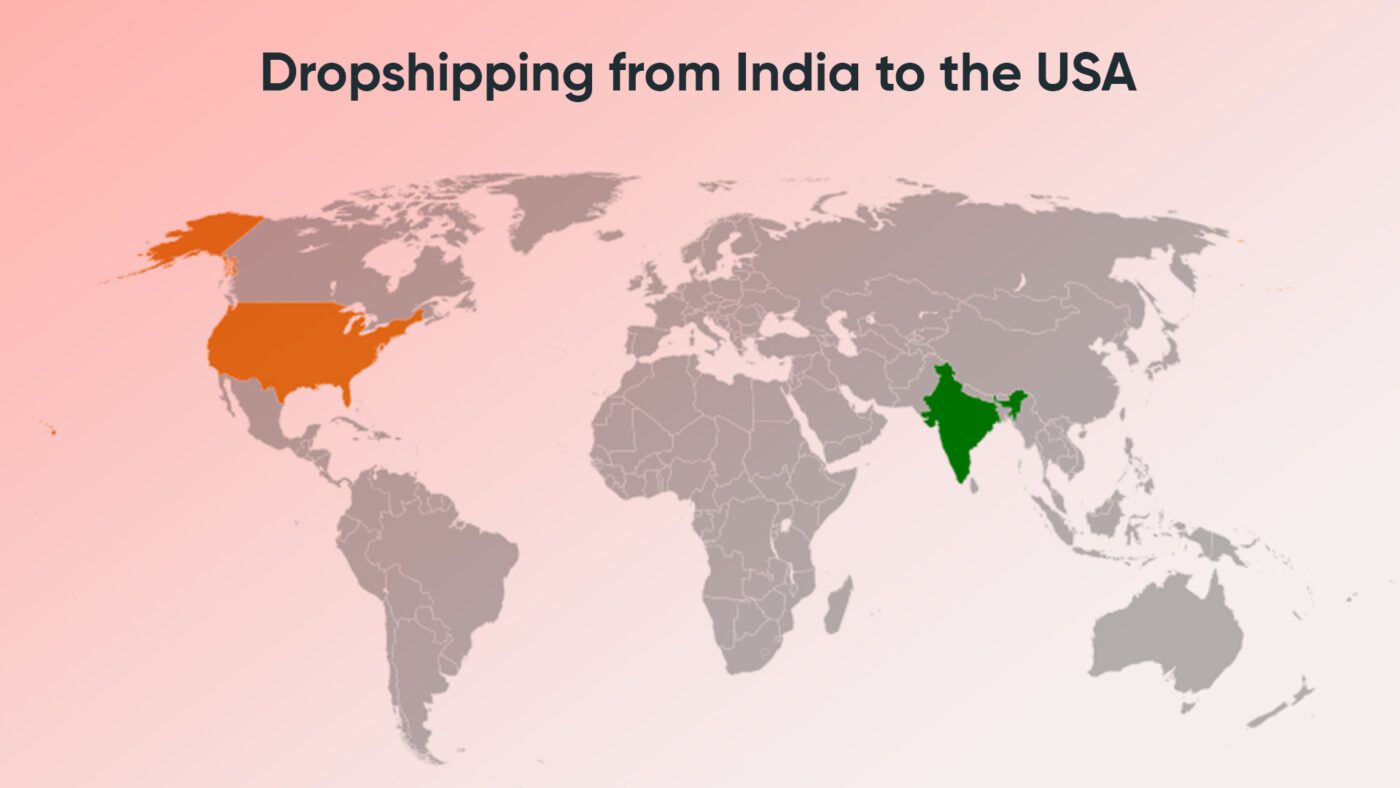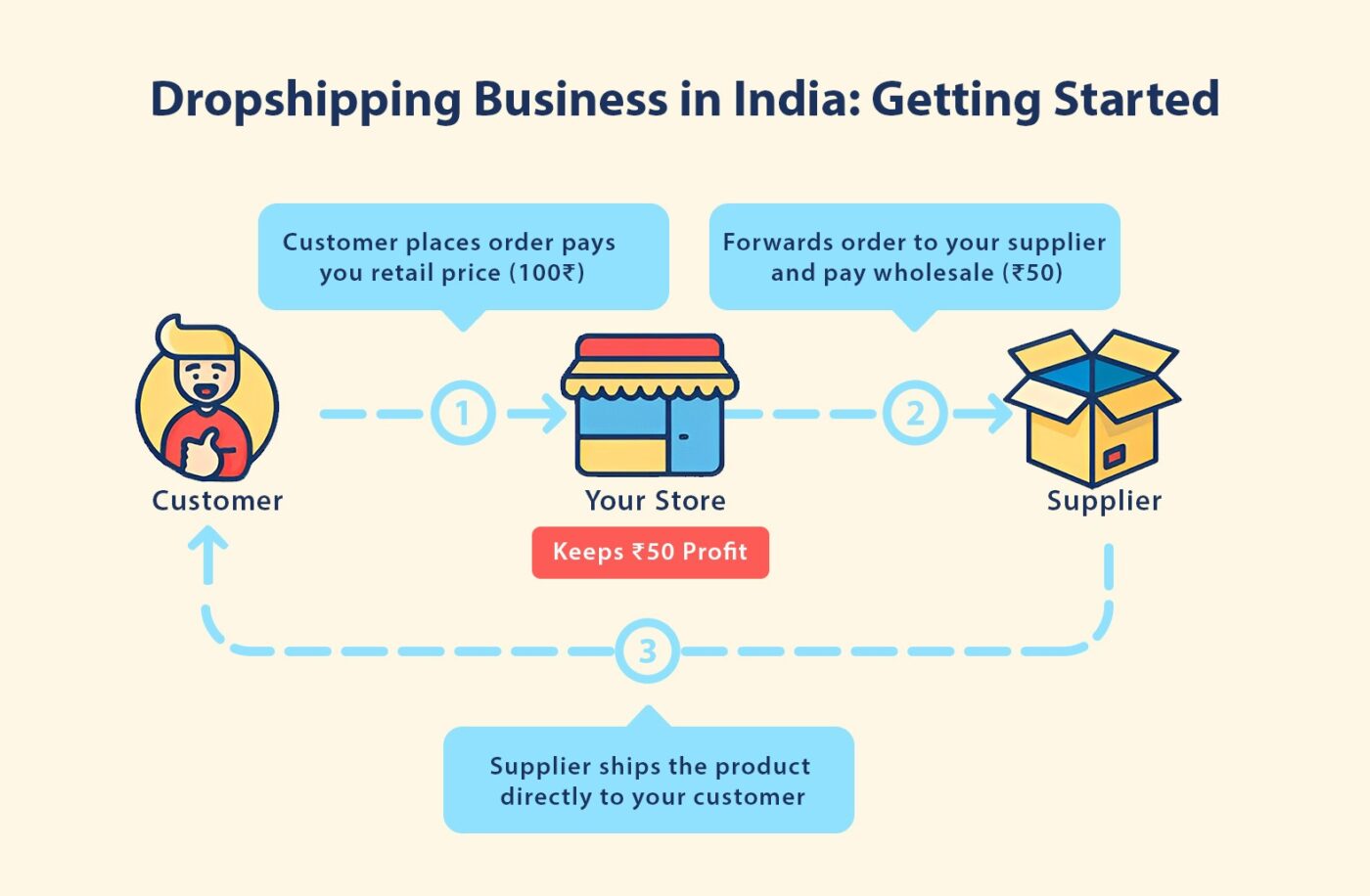In today’s ever-evolving global landscape, traditional retail paradigms are being redefined. Enter dropshipping, a revolutionary business model that seamlessly connects suppliers and customers while bypassing the complexities of inventory management and extensive capital investment. This guide delves into the intricate world of dropshipping from India to the USA, exploring its nuances, benefits, challenges, and offering a detailed step-by-step roadmap to establishing a thriving cross-continental dropshipping venture.
Understanding Dropshipping
At its core, dropshipping is a retail fulfillment strategy that eliminates the need for a store to stock products. Instead, when a customer places an order, the store purchases the product from a third-party supplier who directly ships it to the customer. This innovative approach has gained traction due to its low barriers to entry, operational flexibility, and potential for substantial profits.
The Dropshipping Workflow
The dropshipping process is elegantly straightforward:
Store Setup: Establish an online store and showcase products sourced from your chosen dropshipping suppliers.
Customer Interaction: Visitors browse your store, select products, and place orders.
Supplier Coordination: Transmit order details to your suppliers, including shipping information.
Fulfillment: Suppliers package and dispatch products directly to customers.
Profit Generation: You retain the difference between the retail price and the supplier’s cost, generating your profit.
Why Choose Dropshipping from India to the USA?
Venturing into the realm of dropshipping from India to the USA opens the door to a plethora of compelling advantages that make this cross-continental business model an enticing proposition for aspiring entrepreneurs. Let’s delve deeper into the enticing reasons behind choosing this dynamic approach:
1. Low Cost of Products:
India has long been celebrated for its diverse and cost-effective production capabilities. The country’s thriving manufacturing sector provides access to a wide array of products at competitive prices. By harnessing India’s cost-efficient production landscape, you can offer appealing deals to your American customers, effectively capturing their attention and driving sales.
2. Large and Growing Market:
The United States boasts one of the largest consumer markets globally, characterized by its diversity and ever-evolving preferences. This vast consumer base presents a golden opportunity to tap into a multitude of niches and product categories. By catering to the diverse tastes and needs of the American audience, you stand to unlock substantial profit potential and sustainable growth.
3. Simplified Logistics:
Modern advancements in logistics and transportation infrastructure have significantly streamlined the process of shipping products from India to the USA. Enhanced shipping networks, efficient customs procedures, and technological innovations have culminated in more cost-effective and expedited cross-border shipping. This, in turn, translates to reduced shipping times and enhanced customer satisfaction, a critical factor in building long-lasting customer relationships.
4. Flexible Business Model:
Dropshipping provides an unparalleled level of flexibility, allowing entrepreneurs to experiment with various niches, products, and business strategies. Unlike traditional retail models that require substantial upfront investment in inventory, dropshipping empowers you to explore different avenues without committing to large quantities. This adaptability enables you to swiftly adapt to market trends, capitalize on emerging opportunities, and optimize your offerings for maximum profitability.
5. Innovative Technological Integration:
The fusion of dropshipping and modern technology results in a business model that can be efficiently managed from virtually anywhere. With an internet connection and a computer, you can seamlessly oversee your operations, manage inventory, process orders, and engage with customers. This digital autonomy liberates you from geographical constraints, enabling you to effectively run your business while navigating time zone differences.
6. Reduced Financial Risk:
Unlike traditional retail models that demand substantial capital investment in inventory, dropshipping significantly mitigates financial risk. Without the need to purchase and stock products upfront, you are shielded from the uncertainties associated with unsold inventory. This risk reduction fosters a more stable and financially viable business trajectory.
In essence, dropshipping from India to the USA represents a convergence of advantageous factors that align to create a highly promising business venture. By capitalizing on India’s cost-effective manufacturing capabilities, tapping into the vast American market, leveraging streamlined logistics, embracing a flexible business approach, integrating cutting-edge technology, and minimizing financial risk, you position yourself at the forefront of an exciting cross-continental trade opportunity.
As you embark on this journey, remember that meticulous research, strategic planning, and a customer-centric approach will be your guiding principles. By harnessing the power of dropshipping, you have the potential to carve your path to success and make a meaningful impact on the dynamic landscape of international commerce.
Overcoming Challenges: Navigating the Path to Success
Embarking on the journey of dropshipping from India to the USA is undoubtedly an exciting endeavor, but it’s important to acknowledge and proactively address the challenges that may arise along the way. Successfully navigating these obstacles is key to establishing a resilient and prosperous cross-continental dropshipping venture. Let’s delve deeper into the challenges you may encounter and explore comprehensive strategies to overcome them:
1. Currency Exchange Rates:
Currency fluctuations can introduce an element of uncertainty into your profit margins. The exchange rates between the Indian Rupee (INR) and the US Dollar (USD) can impact the cost of your products and subsequently affect your pricing strategies. To mitigate this challenge:
- Dynamic Pricing: Implement a dynamic pricing strategy that adjusts product prices in real-time based on currency fluctuations. This ensures that your profit margins remain stable even when exchange rates fluctuate.
- Hedging Techniques: Consider employing currency hedging techniques to minimize the risks associated with currency volatility. These techniques involve financial instruments that protect your business from adverse exchange rate movements.
2. Extended Shipping Times:
International shipping inherently entails longer delivery times compared to domestic orders. While customers are generally aware of the international nature of their orders, it’s crucial to manage their expectations and address this challenge head-on:
- Clear Communication: Provide transparent and accurate information about shipping times on your website and during the checkout process. Clearly communicate estimated delivery windows to manage customer expectations.
- Offer Expedited Shipping: Collaborate with suppliers who offer expedited shipping options. This allows customers to choose faster shipping methods, reducing the impact of extended delivery times.
3. Round-the-Clock Customer Support:
Operating a dropshipping business across different time zones can pose a challenge when it comes to providing timely customer support. To ensure exceptional customer service:
- Automated Solutions: Implement AI-powered chatbots that can provide immediate responses to common inquiries during off-hours. These bots can assist customers and direct them to relevant resources until your support team is available.
- Outsource Support: Consider outsourcing customer support to specialized agencies or freelancers who can provide round-the-clock assistance, ensuring your customers receive prompt attention.
4. Regulatory Compliance:
Familiarizing yourself with US regulations, import duties, and taxes is an essential aspect of successful cross-border dropshipping. Navigating the intricacies of regulatory compliance requires a proactive approach:
- Legal Consultation: Collaborate with legal experts who specialize in international trade and e-commerce regulations. Their insights will help you navigate the complexities of compliance and avoid legal complications.
- Transparency: Clearly communicate to customers any potential customs duties or taxes they may incur upon receiving their orders. This transparency fosters trust and prevents surprises.
5. Supplier Reliability:
Partnering with trustworthy and dependable suppliers is fundamental to the success of your dropshipping venture. Ensuring a seamless supplier relationship requires diligent efforts:
- Supplier Vetting: Conduct thorough due diligence when selecting suppliers. Research their reputation, product quality, and reliability in terms of order fulfillment and shipping.
- Communication: Maintain open lines of communication with your suppliers. Regularly touch base to discuss inventory levels, potential issues, and any changes in shipping processes.
6. Market Saturation and Competition:
As the popularity of dropshipping grows, so does the level of competition within the industry. To stand out and secure your market share:
- Unique Value Proposition: Define a compelling and unique value proposition that sets your dropshipping business apart from competitors. This could include exclusive product offerings, exceptional customer service, or innovative marketing strategies.
- Continuous Innovation: Regularly refresh your product offerings to align with market trends and evolving customer preferences. Stay attuned to consumer needs and adjust your product selection accordingly.
7. Intellectual Property Concerns:
Ensuring that the products you source and sell do not infringe upon intellectual property rights is paramount. Safeguard your business from legal disputes by:
- Thorough Research: Conduct comprehensive research to verify the legitimacy of the products you intend to sell. Check for patents, trademarks, and copyrights to ensure you’re not unintentionally violating intellectual property rights.
- Authenticity Documentation: Request authenticity documentation from your suppliers to verify the legitimacy of their products. This documentation can provide you with legal protection and assurance.
8. Cultural Sensitivity:
Understanding and respecting cultural differences between India and the USA is crucial to avoid misunderstandings and cultivate positive customer experiences:
- Localized Marketing: Tailor your marketing campaigns and product descriptions to resonate with your American audience. Consider cultural nuances, preferences, and trends to effectively engage your target demographic.
- Clear Communication: Ensure that your communication is culturally sensitive and free from any unintentional biases. Strive to create a shopping experience that is inclusive and respectful of diverse backgrounds.
By proactively addressing these challenges with strategic planning, open communication, and a customer-centric mindset, you can successfully navigate the intricate path of dropshipping from India to the USA. Embrace each challenge as an opportunity for growth and learning, and use your resilience and adaptability to lay the foundation for a thriving cross-continental dropshipping enterprise. Remember, overcoming challenges is an integral part of achieving lasting success in the dynamic world of international commerce.
.
Step-by-Step Guide to Launching a Successful Dropshipping Business
Embarking on the journey of dropshipping from India to the USA demands a systematic approach. Follow this comprehensive step-by-step guide to establish a thriving cross-continental dropshipping enterprise:
1. Niche Selection:
Begin by conducting thorough research into the American market to identify profitable niches that resonate with your interests and expertise. A well-chosen niche sets the foundation for a successful dropshipping venture.
2. Supplier Sourcing:
Connect with reputable Indian suppliers who offer high-quality products and reliable shipping to the USA. Utilize platforms like AliExpress, Oberlo, and SaleHoo to establish a strong network of trusted suppliers.
3. Online Store Creation:
Choose a user-friendly e-commerce platform such as Shopify, WooCommerce, or Magento to set up your online store. Customize its appearance to align with your brand and populate it with carefully curated products from your chosen suppliers.
4. Strategic Marketing:
Leverage a variety of marketing strategies to drive traffic to your online store. Engage with potential customers through social media, employ content marketing techniques, optimize your store for search engines (SEO), and consider paid advertising to maximize your reach.
5. Exceptional Customer Service:
Prioritize exceptional customer support to build trust and encourage repeat business. Swiftly address customer inquiries, promptly process orders, and resolve any issues that may arise. Providing a seamless shopping experience is key to your business’s success.
By meticulously following these steps, you’ll lay a strong foundation for your dropshipping venture, ensuring its growth and success in the dynamic landscape of international commerce. Remember, dedication, comprehensive research, and adaptability are your allies on this exciting journey.
In Conclusion
Embarking on the journey of dropshipping from India to the USA presents a promising avenue for ambitious entrepreneurs seeking to tap into a lucrative market with manageable overhead. By meticulously navigating challenges and adhering to the outlined steps, you can lay the foundations for a thriving cross-border dropshipping enterprise. Remember, dedication, comprehensive research, and adaptability will be your allies in converting your dropshipping venture into a profitable, globally-reaching success story. Embrace this exhilarating endeavor and make your mark in the dynamic realm of international commerce.




